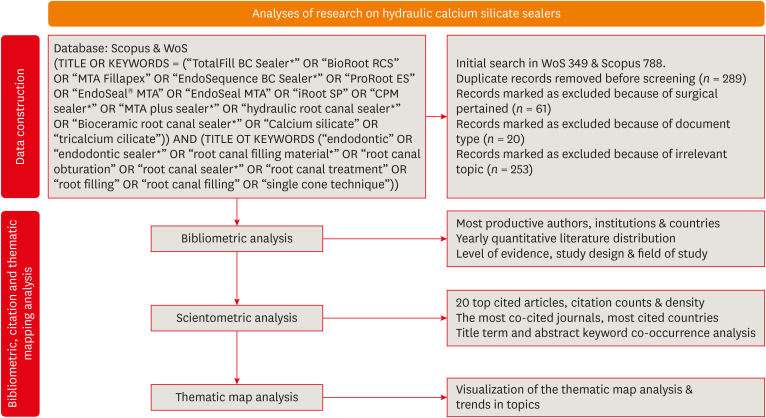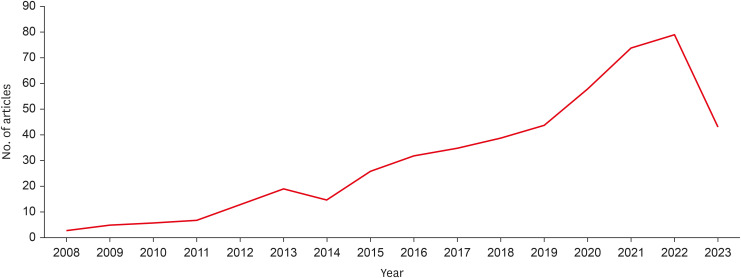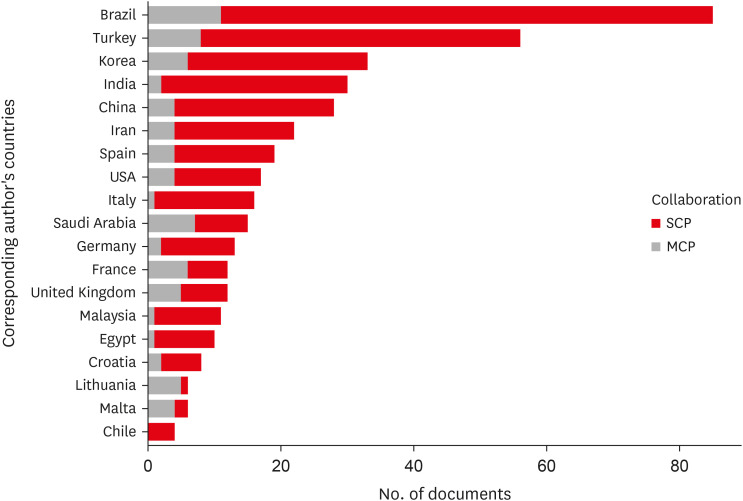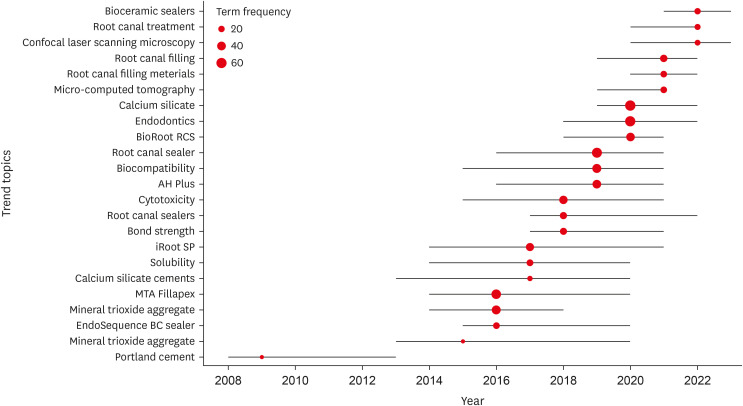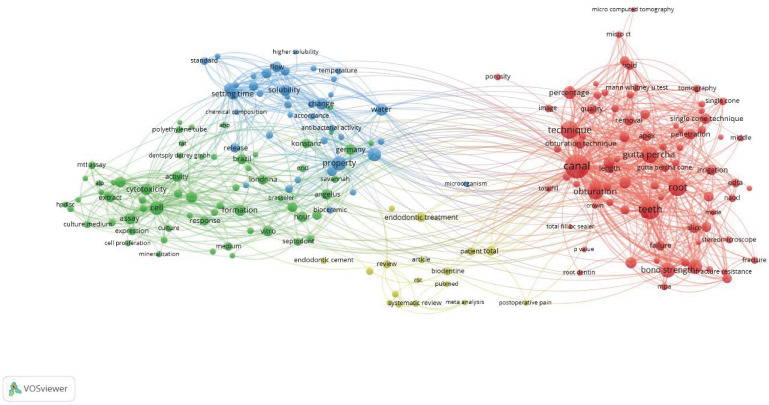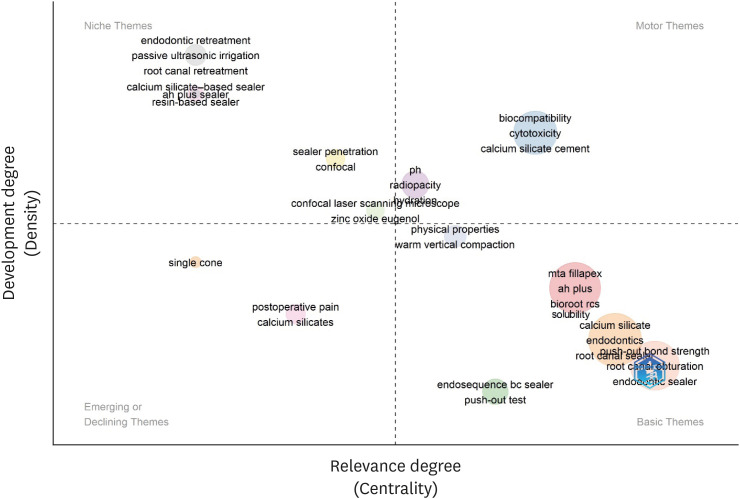Restor Dent Endod.
2023 Nov;48(4):e41. 10.5395/rde.2023.48.e41.
A scientometric, bibliometric, and thematic map analysis of hydraulic calcium silicate root canal sealers
- Affiliations
-
- 1Department of Endodontology, School of Dentistry, Aristotle University of Thessaloniki, Thessaloniki, Greece
- 2Department of Dentoalveolar Surgery, Surgical Implantology & Radiology, School of Dentistry, Aristotle University of Thessaloniki, Thessaloniki, Greece
- KMID: 2548762
- DOI: http://doi.org/10.5395/rde.2023.48.e41
Abstract
Objectives
This scientometric and bibliometric analysis explored scientific publications related to hydraulic calcium silicate-based (HCSB) sealers used in endodontology, aiming to describe basic bibliometric indicators and analyze current research trends.
Materials and Methods
A comprehensive search was conducted in Web of Science and Scopus using specific HCSB sealer and general endodontic-related terms. Basic research parameters were collected, including publication year, authorship, countries, institutions, journals, level of evidence, study design and topic of interest, title terms, author keywords, citation counts, and density.
Results
In total, 498 articles published in 136 journals were retrieved for the period 2008– 2023. Brazil was the leading country, and the universities of Bologna in Italy and Sao Paolo in Brazil were represented equally as leading institutions. The most frequently occurring keywords were “calcium silicate,” “root canal sealer MTA-Fillapex,” and “biocompatibility,” while title terms such as “calcium,” “sealers,” “root,” “canal,” “silicate based,” and “endodontic” occurred most often. According to the thematic map analysis, “solubility” appeared as a basic theme of concentrated research interest, and “single-cone technique” was identified as an emerging, inadequately developed theme. The co-occurrence analysis revealed 4 major clusters centered on sealers’ biological and physicochemical properties, obturation techniques, retreatability, and adhesion.
Conclusions
This analysis presents bibliographic features and outlines changing trends in HCSB sealer research. The research output is dominated by basic science articles scrutinizing the biological and specific physicochemical properties of commonly used HCSB sealers. Future research needs to be guided by studies with a high level of evidence that utilize innovative, sophisticated technologies.
Keyword
Figure
Reference
-
1. Best SM, Porter AE, Thian ES, Huang J. Bioceramics: past, present and for the future. J Eur Ceram Soc. 2008; 28:1319–1327.
Article2. Torabinejad M, Hong CU, Lee SJ, Monsef M, Pitt Ford TR. Investigation of mineral trioxide aggregate for root-end filling in dogs. J Endod. 1995; 21:603–608. PMID: 8596081.
Article3. Parirokh M, Torabinejad M, Dummer PM. Mineral trioxide aggregate and other bioactive endodontic cements: an updated overview - Part I: vital pulp therapy. Int Endod J. 2018; 51:177–205. PMID: 28836288.
Article4. Camilleri J, Atmeh A, Li X, Meschi N. Present status and future directions: Hydraulic materials for endodontic use. Int Endod J. 2022; 55(Supplement 3):710–777. PMID: 35167119.
Article5. Camilleri J. Classification of hydraulic cements used in dentistry. Front Dent Med. 2020; 1:9.
Article6. Grossman L. Endodontic practice. 11th ed. Philadelphia, PA: Lea & Febiger;1988.7. Gutmann J. Grossman's endodontic practice - 13th edition. J Conserv Dent. 2016; 19:494.8. Donnermeyer D, Bürklein S, Dammaschke T, Schäfer E. Endodontic sealers based on calcium silicates: a systematic review. Odontology. 2019; 107:421–436. PMID: 30554288.
Article9. Weller RN, Tay KC, Garrett LV, Mai S, Primus CM, Gutmann JL, et al. Microscopic appearance and apical seal of root canals filled with gutta-percha and ProRoot Endo Sealer after immersion in a phosphate-containing fluid. Int Endod J. 2008; 41:977–986. PMID: 19133087.
Article10. Li J, Chen L, Zeng C, Liu Y, Gong Q, Jiang H. Clinical outcome of bioceramic sealer iRoot SP extrusion in root canal treatment: a retrospective analysis. Head Face Med. 2022; 18:28. PMID: 36045447.
Article11. Kim JH, Cho SY, Choi Y, Kim DH, Shin SJ, Jung IY. Clinical efficacy of sealer-based obturation using calcium silicate sealers: a randomized clinical trial. J Endod. 2022; 48:144–151. PMID: 34856212.
Article12. López-García S, Pecci-Lloret MR, Guerrero-Gironés J, Pecci-Lloret MP, Lozano A, Llena C, et al. Comparative cytocompatibility and mineralization potential of Bio-C sealer and TotalFill BC sealer. Materials (Basel). 2019; 12:3087. PMID: 31546696.
Article13. Remya NS, Sangeetha VP, Mohanan PV. Chapter 19. Toxicity studies of biomedical products. Mohanan PV, editor. Biomedical product and materials evaluation. 1st ed. Kidlington: Elsevier;2022. p. 483–500.14. Seo DG, Lee D, Kim YM, Song D, Kim SY. Biocompatibility and mineralization activity of three calcium silicate-based root canal sealers compared to conventional resin-based sealer in human dental pulp stem cells. Materials (Basel). 2019; 12:2482. PMID: 31387241.
Article15. Silva Almeida LH, Moraes RR, Morgental RD, Pappen FG. Are premixed calcium silicate-based endodontic sealers comparable to conventional materials? A systematic review of in vitro studies. J Endod. 2017; 43:527–535. PMID: 28216270.
Article16. Poggio C, Dagna A, Ceci M, Meravini MV, Colombo M, Pietrocola G. Solubility and pH of bioceramic root canal sealers: a comparative study. J Clin Exp Dent. 2017; 9:e1189–e1194. PMID: 29167707.
Article17. Siboni F, Taddei P, Zamparini F, Prati C, Gandolfi MG. Properties of BioRoot RCS, a tricalcium silicate endodontic sealer modified with povidone and polycarboxylate. Int Endod J. 2017; 50(Supplement 2):e120–e136. PMID: 28881478.18. Vitti RP, Prati C, Silva EJ, Sinhoreti MA, Zanchi CH, de Souza e Silva MG, et al. Physical properties of MTA Fillapex sealer. J Endod. 2013; 39:915–918. PMID: 23791263.19. Prüllage RK, Urban K, Schäfer E, Dammaschke T. Material properties of a tricalcium silicate-containing, a mineral trioxide aggregate-containing, and an epoxy resin-based root canal sealer. J Endod. 2016; 42:1784–1788. PMID: 27769676.
Article20. Katakidis A, Sidiropoulos K, Koulaouzidou E, Gogos C, Economides N. Flow characteristics and alkalinity of novel bioceramic root canal sealers. Restor Dent Endod. 2020; 45:e42. PMID: 33294407.
Article21. Almeida MM, Rodrigues CT, Matos AA, Carvalho KK, Silva EJ, Duarte MA, et al. Analysis of the physicochemical properties, cytotoxicity and volumetric changes of AH Plus, MTA Fillapex and TotalFill BC Sealer. J Clin Exp Dent. 2020; 12:e1058–e1065. PMID: 33262872.
Article22. Park MG, Kim IR, Kim HJ, Kwak SW, Kim HC. Physicochemical properties and cytocompatibility of newly developed calcium silicate-based sealers. Aust Endod J. 2021; 47:512–519. PMID: 33894082.
Article23. Lim ES, Park YB, Kwon YS, Shon WJ, Lee KW, Min KS. Physical properties and biocompatibility of an injectable calcium-silicate-based root canal sealer: in vitro and in vivo study. BMC Oral Health. 2015; 15:129. PMID: 26490372.24. van Eck NJ, Waltman L. Software survey: VOSviewer, a computer program for bibliometric mapping. Scientometrics. 2010; 84:523–538. PMID: 20585380.
Article25. Cobo MJ, López-Herrera AG, Herrera-Viedma E, Herrera F. An approach for detecting, quantifying, and visualizing the evolution of a research field: a practical application to the Fuzzy Sets Theory field. J Informetrics. 2011; 5:146–166.
Article26. Moed HF. New developments in the use of citation analysis in research evaluation. Arch Immunol Ther Exp (Warsz). 2009; 57:13–18. PMID: 19219533.
Article27. Shamszadeh S, Asgary S, Nosrat A. Regenerative endodontics: a scientometric and bibliometric analysis. J Endod. 2019; 45:272–280. PMID: 30803534.
Article28. Kodonas K, Fardi A, Gogos C, Economides N. Scientometric analysis of vital pulp therapy studies. Int Endod J. 2021; 54:220–230. PMID: 33012010.
Article29. Guerrero-Gironés J, Forner L, Sanz JL, Rodríguez-Lozano FJ, Ghilotti J, Llena C, et al. Scientific production on silicate-based endodontic materials: evolution and current state: a bibliometric analysis. Clin Oral Investig. 2022; 26:5611–5624.
Article30. Aria M, Cuccurullo C. Bibliometrix: an R-tool for comprehensive science mapping analysis. J Informetrics. 2017; 11:959–975.31. Prati C, Gandolfi MG. Calcium silicate bioactive cements: biological perspectives and clinical applications. Dent Mater. 2015; 31:351–370. PMID: 25662204.
Article32. Han L, Okiji T. Uptake of calcium and silicon released from calcium silicate-based endodontic materials into root canal dentine. Int Endod J. 2011; 44:1081–1087. PMID: 21777256.
Article33. Candeiro GT, Correia FC, Duarte MA, Ribeiro-Siqueira DC, Gavini G. Evaluation of radiopacity, pH, release of calcium ions, and flow of a bioceramic root canal sealer. J Endod. 2012; 38:842–845. PMID: 22595123.
Article34. Callon M, Courtial JP, Turner WA, Bauin S. From translations to problematic networks: an introduction to co-word analysis. Soc Sci Inf (Paris). 1983; 22:191–235.
Article35. Aslan T, Dönmez Özkan H. The effect of two calcium silicate-based and one epoxy resin-based root canal sealer on postoperative pain: a randomized controlled trial. Int Endod J. 2021; 54:190–197. PMID: 32929721.
Article36. Kim SR, Kwak SW, Lee JK, Goo HJ, Ha JH, Kim HC. Efficacy and retrievability of root canal filling using calcium silicate-based and epoxy resin-based root canal sealers with matched obturation techniques. Aust Endod J. 2019; 45:337–345. PMID: 30614168.
Article37. Chopra V, Davis G, Baysan A. Clinical and radiographic outcome of non-surgical endodontic treatment using calcium silicate-based versus resin-based sealers-a systematic review and meta-analysis of clinical studies. J Funct Biomater. 2022; 13:38. PMID: 35466220.
Article38. Schäfer E, Zandbiglari T. Solubility of root-canal sealers in water and artificial saliva. Int Endod J. 2003; 36:660–669. PMID: 14511222.
Article39. Viapiana R, Flumignan DL, Guerreiro-Tanomaru JM, Camilleri J, Tanomaru-Filho M. Physicochemical and mechanical properties of zirconium oxide and niobium oxide modified Portland cement-based experimental endodontic sealers. Int Endod J. 2014; 47:437–448. PMID: 24033490.
Article40. Aminoshariae A, Primus C, Kulild JC. Tricalcium silicate cement sealers: do the potential benefits of bioactivity justify the drawbacks? J Am Dent Assoc. 2022; 153:750–760. PMID: 35260235.41. Vieira AR, Siqueira JF Jr, Ricucci D, Lopes WS. Dentinal tubule infection as the cause of recurrent disease and late endodontic treatment failure: a case report. J Endod. 2012; 38:250–254. PMID: 22244647.
Article42. Duncan HF, Nagendrababu V, El-Karim IA, Dummer PM. Outcome measures to assess the effectiveness of endodontic treatment for pulpitis and apical periodontitis for use in the development of European Society of Endodontology (ESE) S3 level clinical practice guidelines: a protocol. Int Endod J. 2021; 54:646–654. PMID: 33630330.
Article43. Barborka BJ, Woodmansey KF, Glickman GN, Schneiderman E, He J. Long-term clinical outcome of teeth obturated with resilon. J Endod. 2017; 43:556–560. PMID: 28342476.
Article44. Neelakantan P, Grotra D, Sharma S. Retreatability of 2 mineral trioxide aggregate-based root canal sealers: a cone-beam computed tomography analysis. J Endod. 2013; 39:893–896. PMID: 23791258.
Article45. Donnermeyer D, Bunne C, Schäfer E, Dammaschke T. Retreatability of three calcium silicate-containing sealers and one epoxy resin-based root canal sealer with four different root canal instruments. Clin Oral Investig. 2018; 22:811–817.
Article46. Alsubait S, Alhathlol N, Alqedairi A, Alfawaz H. A micro-computed tomographic evaluation of retreatability of BioRoot RCS in comparison with AH Plus. Aust Endod J. 2021; 47:222–227. PMID: 33119208.
Article47. Aksel H, Küçükkaya Eren S, Askerbeyli Örs S, Serper A, Ocak M, Çelik HH. Micro-CT evaluation of the removal of root fillings using the ProTaper Universal Retreatment system supplemented by the XP-Endo Finisher file. Int Endod J. 2019; 52:1070–1076. PMID: 30715732.
Article48. Sinsareekul C, Hiran-Us S. Comparison of the efficacy of three different supplementary cleaning protocols in root-filled teeth with a bioceramic sealer after retreatment-a micro-computed tomographic study. Clin Oral Investig. 2022; 26:3515–3521.
Article49. Aguiar BA, Frota LM, Taguatinga DT, Vivan RR, Camilleri J, Duarte MA, et al. Influence of ultrasonic agitation on bond strength, marginal adaptation, and tooth discoloration provided by three coronary barrier endodontic materials. Clin Oral Investig. 2019; 23:4113–4122.
Article50. Forghani M, Gharechahi M, Karimpour S. In vitro evaluation of tooth discolouration induced by mineral trioxide aggregate Fillapex and iRoot SP endodontic sealers. Aust Endod J. 2016; 42:99–103. PMID: 26786564.
Article51. Macroberts MH, Macroberts BR. Problems of citation analysis: a critical review. J Am Soc Inf Sci. 1989; 40:342–349.
Article
- Full Text Links
- Actions
-
Cited
- CITED
-
- Close
- Share
- Similar articles
-
- Calcium silicate-based root canal sealers: a literature review
- Nanoleakage of apical sealing using a calcium silicate-based sealer according to canal drying methods
- Biocompatibility and Bioactivity of Four Different Root Canal Sealers in Osteoblastic Cell Line MC3T3-El
- Cytotoxicity and genotoxicity of newly developed calcium phosphate-based root canal sealers
- Evaluation of the radiopacity and cytotoxicity of resinous root canal sealers

